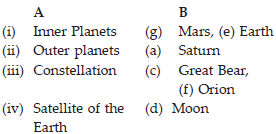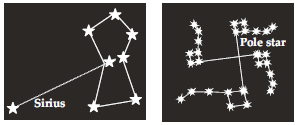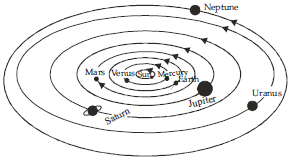Stars and The Solar System (Physics) Class 8 - NCERT Questions
Which of the following is NOT a member of the solar system?
(A) An asteroid (B) A satellite
(C) A constellation (D) A comet
(C) A constellation
Q 2.Which of the following is NOT a planet of the sun?
(A) Sirius (B) Mercury
(C) Saturn (D) Earth
(A) Sirius
Q 3.Phases of the moon occur because
(A) we can see only that part of the moon which reflects light towards us.
(B) our distance from the Moon keeps changing
(C) the shadow of the Earth covers only a part of the moon’s surface
(D) the thickness of the moon’s atmosphere is not constant.
(A) we can see only that part of the moon which reflects light towards us.
Q 4.Fill in the blank :
(A) The planet which is farthest from the Sun is ..................... .
(B) The planet which appears reddish in colour is ..................... .
(C) A group of stars that appear to form a pattern in the sky is known as a ..................... .
(D) A celestial body that revolves around a planet is known as ..................... .
(E) Shooting stars are actually not ......................
(F) Asteroids are found between the orbits of ..................... and ..................... .
(A) Neptune, (B) Mars, (C) constellation, (D) Satellite, (E) Meteors,, (F) Mars and Jupiter.
Q 5.Mark the following statements as true (T) or false (F) :
(A) Pole star is a member of the solar system.
(B) Mercury is the smallest planet of the solar system
(C) Uranus is the farthest planet in our solar system.
(D) INSAT is an artificial satellite.
(E) There are nine planets in our solar system.
(F) Constellation Orion can be seen only with the telescope.
(A) False, (B) False, (C) False, (D) True, (E) False, (F) False
Q 6.Match items in Column A with one or more items of Column B :


In which part of the sky can you find Venus if it is visible as an evening star?
SOLUTION:In western sky.
Q 8.Name the largest planet of the solar system.
SOLUTION:Jupiter
Q 9.What is a constellation? Name any two constellations.
SOLUTION:A group of stars in a recognizable shape is called a constellation. Orion and the Great Bear are constellations.
Q 10.Draw sketches to show the relative positions of prominent stars in (i) Ursa Major and (ii) Orion.
SOLUTION: 
Name two objects other than planets which are members of the solar system.
SOLUTION:Meteors and Asteroids.
Q 12.Explain how you can locate the Pole Star with the help of Ursa Major.
SOLUTION:Pole star is situated at the end of the Ursa Major. If a straight line starting from the last two stars is extended towards the north direction, it will lead to the Pole star.
Q 13.Do all the stars in the sky move? Explain.
SOLUTION:All the stars in the sky do not move, but they appear to move from east to west. This is actually due to the rotation of earth on its axis. Earth moves from west to east. So it appears as the stars are rising from east and as the day dawn they sets in the west.
Q 14.Why is the distance between stars expressed in light years? What do you understand by the statement that a star is eight light years away from the earth?
SOLUTION:Stars are millions of kilometres away from the earth. It is not convenient to express such a large distance in the units of km. So the distance of stars from the earth is expressed in time taken by light to travel in one year. Eight light years means time taken by light to travel in eight years.
Q 15.Boojho made the following sketch (figure) of the solar system. Is the sketch correct? If not, correct it.
SOLUTION:No, the sketch made by Boojho is incorrect. The following sketch is correct.
